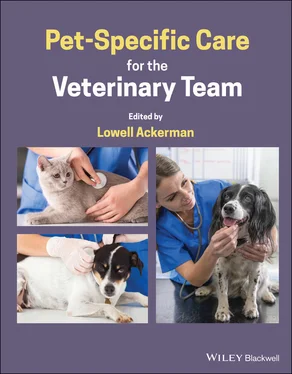Most veterinary practices believe that clients should receive selection counseling before they purchase a pet, but most practices do not offer this important service.
Clients who select an appropriate pet are less likely to relinquish it, and are more prepared for the likely care the pet will need.
Discussing issues proactively allows the team to be regarded as advocates; when such counseling is not provided and problems ensue, the practice can sometimes appear adversarial (you never warned me about that).
Most selection counseling can be performed by the nonveterinary team and it can be a great bonding experience even without veterinary involvement.
It is better for veterinary teams to be involved preemptively in the selection process rather than complain about the results when they are not involved.
1 1 Ackerman, L.J. (2011). The Genetic Connection, 2e. Lakewood, CO: AAHA Press.
2 2 Landsberg, G., Hunthausen, W., and Ackerman, L. (2013). Behavior Problems of the Dog and Cat, 3e. Edinburgh: Elsevier.
1 American Animal Hospital Association‐American Veterinary Medical Association Preventive Health Guidelines Task Force (2011). J. Am. Vet. Med. Assoc. 239 (5): 625–629.
2 Ackerman, L. (2020). Proactive Pet Parenting: Anticipating pet health problems before they happen. Problem Free Publishing.
3 Fivecoat‐Campbell, K. (2020). Adoption marketing. Marketing to the new adopters of shelter and rescue animals. AAHA Trends 36 (2): 51–55.
In pet‐specific care, there is a focus on prevention and early detection. To accomplish early detection, both genotypic and phenotypic tests are needed. Genotypic tests examine an individual's DNA for mutations (variants) or markers that may be correlated with traits and disease risk. Phenotypic tests measure observable features (e.g., blood test results, heart rhythm, body weight, etc.) and diagnostic judgments are made on that basis, and comparisons with so‐called “normal” reference intervals (ranges).
Genotypic tests on their own have value, but they cannot always predict actual risk of diseases. In addition, genotypic tests are available primarily for conditions transmitted as simple Mendelian traits (e.g., von Willebrand disease, progressive rod‐cone dysplasia, mdr1 , etc.), mostly controlled by one set of genes. On the other hand, the most common hereditary conditions encountered in veterinary practice (e.g., atopic dermatitis, hip dysplasia, seizure disorders, etc.) have a more complex pattern of inheritance, often influenced by environmental factors and multiple genes, and confirmed principally through phenotypic testing. Because of this, both genotypic and phenotypic testing are needed as part of most early detection schemes.
Genotypic tests, those that rely on the detection of actual genetic mutations (variants) or markers ( Table 3.11.1), have a lot of benefits. They can be detected at an early age, even as early as one day of age. They don't change over time, so if a genetic mutation is present (or not present) when tested, repeat testing is not needed – the results should not change over time. In fact, if the parents have been tested for a specific variant, the status of the offspring can be inferred from such testing. So, if two Labrador retrievers are both “clear” for progressive rod‐cone degeneration (prcd) and they are bred together, theoretically it should not be possible for the pups to develop that specific form of progressive retinal atrophy (PRA) if the testing has been done by a reliable genetic testing facility ( http://bit.ly/2YWXBscor https://dogwellnet.com/ctp). Of course, mistakes do happen. In this instance, the most likely cause for pups testing “affected” for prcd when the parents tested “clear” would be that the breeders made a mistake in identifying which animals were the actual parents. Theoretically, it would also be possible that the pups developed a spontaneous mutation, but this is very rare.
| 2,8‐Dihydroxyadenine Urolithiasis Type IA |
| Achromatopsia |
| Acral Mutilation Syndrome |
| Acute Respiratory Distress Syndrome |
| Aggression (markers) |
| Alanine Aminotransferase (ALT) Activity |
| Alexander Disease |
| Amelogenesis Imperfecta |
| Arrhythmogenic Right Ventricular Cardiomyopathy |
| Autoimmune lymphoproliferative Syndrome |
| Bardet–Biedl Syndrome |
| Bernard Soulier Syndrome |
| Brain Hypomyelination |
| Burmese Head Defect |
| Canine Leukocyte Adhesion Deficiency Types I & III |
| Canine Multifocal Retinopathy (CMR 1, 2 & 3) |
| Canine Multiple System Degeneration |
| Cardiomyopathy, Dilated (DCM1 and DCM2) |
| Cardiomyopathy, Hypertrophic |
| Catalase Deficiency |
| Centronuclear Myopathy |
| Cerebellar Ataxia |
| Cerebellar Cortical Degeneration |
| Cerebellar Hypoplasia |
| Cerobellar Abiotrophy |
| Chondrodysplasia |
| Chondrodystrophy and intervertebral Disc Disease |
| Ciliary Dyskinesia |
| Cleft Lip with Syndactyly |
| Cleft Lip/Palate |
| Cobalamin Malabsorption |
| Collie Eye Anomaly/Choroidal Hypoplasia |
| Color Dilution Alopecia |
| Complement 3 (C3) deficiency |
| Cone Degeneration |
| Cone‐Rod Dystrophy (1, 2, 3, 4, SWD) |
| Congenital Hypothyroidism with Goiter |
| Congenital Keratoconjunctivities Sicca and Ichthyosiform Dermatosis |
| Congenital Macrothrombocytopenia |
| Congenital Myasthenic Syndrome |
| Congenital Stationary Night Blindness |
| Copper Toxicosis |
| Craniomandibular Osteopathy |
| Curly Coat Dry Eye Syndrome |
| Cyclic Hematopoiesis |
| Cyclic Neutropenia |
| Cystic renal Dysplasia and Hepatic Fibrosis |
| Cystinuria (Types I‐A, II‐A, II‐B) |
| Dandy–Walker Malformation |
| Day Blindess |
| Deafness and Vestibular Syndrome |
| Degenerative Myelopathy |
| Dental Hypomineralization |
| Dermatomyositis |
| Dystrophic Epidermolysis Bullosa |
| Early Adult Onset Deafness |
| Early Onset Progressive Polyneuropathy |
| Ectodermal Dysplasia |
| Elliptocytosis |
| Encephalopathy |
| Epidermolysis Bullosa Simplex |
| Epidermolytic Hyperkeratosis |
| Epilepsy (variants) |
| Episodic Falling Syndrome |
| Exercise‐Induced Collapse |
| Exercise‐Induced Metabolic Myopathy |
| Factor IX Deficiency (Hemophilia B) |
| Factor VII Deficiency |
| Factor VIII Deficiency (Hemophilia A) |
| Factor XI Deficiency |
| Factor XII Deficiency |
| Familial Congenital Methemoglobinemia |
| Familial Juvenile Epilepsy |
| Familial Nephropathy |
| Fanconi Syndrome |
| Fucosidosis |
| Gall Bladder Mucocele Formation |
| Gangliosidosis (GM1 & GM2) |
| Generalized Myoclonic Epilepsy |
| Glanzmann's Thrombasthenia |
| Glaucoma |
| Globoid Cell Leukodystrophy/Krabbe’s Disease |
| Glomerulopathy KIRREL2 |
| Glycogen Storage Disease IA, II, III, IIIA |
| Goniodysgenesis and Glaucoma |
| Hereditary Ataxia |
| Hereditary Cataracts |
| Hereditary Deafness (PTPRQ) |
| Hereditary Footpad Hyperkeratosis |
| Hereditary Nasal Parakeratosis |
| Hereditary Nephropathy |
| Hereditary Nephropathy (Alport Syndrome) |
| Hip Dysplasia (markers) |
| Histiocytic Sarcoma (marker) |
| Hyperekplexia (Startle Disease) |
| Hyperoxaluria |
| Hyperuricosuria |
| Hypoadrenocorticism |
| Hypocatalasia |
| Hypokalemic Polymyopathy |
| Hypomyelination and Tremors |
| Ichthyosis |
| Inflammatory Myopathy |
| Inherited Myopathy |
| Iron‐Deficiency Anemia |
| Juvenile Encephalopathy |
| Juvenile Epilepsy |
| Juvenile Laryngeal Paralysis and Polyneuropathy |
| Juvenile Myoclonic Epilepsy |
| Juvenile Onset Polyneuropathy |
| L2‐ Hydroxyglutaric Aciduria |
| Lagotto Storage Disease |
| Laryngeal Paralysis |
| Lethal Acrodermatitis MKLN1 |
| Leukoencephalomyelopathy |
| Ligneous Membranitis |
| Lipoprotein Lipase Deficiency |
| Long QT Syndrome |
| Lundehund Syndrome |
| Lupoid Dermatosis |
| Macrothrombocytopenia |
| Macular Corneal Dystrophy |
| Malignant Hyperthermia |
| Mannosidosis |
| May–Hegglin Anomaly |
| Microphthalmia, Anophthalmia, and Coloboma |
| Mucolipidosis II |
| Mucopolysaccharidosis (I, IIIa, VI, VII, VIII) |
| Mullerian Duct Syndrome |
| Multidrug Resistance 1 |
| Multiple System Degeneration |
| Muscular Dystrophy |
| Musladin–Lueke Syndrome |
| Mycobacterium Avium Susceptibility |
| Myeloperoxidase deficiency |
| Myostatin Deficiency |
| Myotonia Congenita |
| Myotonia Hereditaria |
| Myotubular Myopathy |
| Narcolepsy |
| Necrotizing Meningoencephalitis |
| Nemaline Myopathy |
| Neonatal Ataxia |
| Neonatal Cerebellar Cortical Degeneration |
| Neonatal Encephalopathy |
| Neonatal Encephalopathy with Seizures |
| Neonatal Neuroaxonal Dystrophy |
| Neuroaxonal Dystrophy |
| Neurodegenerative Vacuolar Storage Disease |
| Neuronal Ceroid Lipofuscinosis 1, 2, 4a, 5, 6, 7, 8, 10, A, MFSD8 |
| Niemann‐Pick C |
| Oculoskeletal Dysplasia |
| Osteochondrodysplasia |
| Osteochondromatosis |
| Osteogenesis Imperfecta |
| P2Y12 Receptor Platelet Disorder |
| Palmoplantar Keratoderma |
| Pancreatitis (marker) |
| Pannus (marker) |
| Paroxysmal Dyskinesia |
| Periodic Fever Syndrome |
| Persistent Mullerian Duct Syndrome |
| Phosphofructokinase Deficiency |
| Pituitary Dwarfism |
| Platelet Dysfunction |
| Platelet Procoagulant Deficiency – Scott Syndrome |
| Polycystic Kidney Disease |
| Polyneuropathy |
| Pompe Disease |
| Porphyria |
| Postoperative Hemorrhage |
| Prekallikrein Deficiency |
| Primary Ciliary Dyskinesia |
| Primary Lens Luxation |
| Primary Open Angle Glaucoma |
| Progress Retinal Atrophy ‐ crd4/cord1 |
| Progressive Neuronal Abiotrophy |
| Progressive Retinal Atrophy ‐ AD/RHO |
| Progressive Retinal Atrophy ‐ CNGA |
| Progressive Retinal Atrophy ‐ CNGB1 |
| Progressive Retinal Atrophy ‐ crd (1, 2, 3, 4) |
| Progressive Retinal Atrophy ‐ erd |
| Progressive Retinal Atrophy ‐ Golden Retriever (1 & 2) |
| Progressive Retinal Atrophy ‐ IG‐PRA1 |
| Progressive Retinal Atrophy ‐ Late Onset |
| Progressive Retinal Atrophy ‐ rcd (1, 1a, 2, 3, 4) |
| Progressive Retinal Atrophy ‐ RdAc |
| Progressive Retinal Atrophy ‐ Rdy |
| Progressive Retinal Atrophy ‐ SAG |
| Progressive Retinal Atrophy ‐ Type 1, 3, 4 |
| Progressive Retinal Atrophy ‐ Type A, B |
| Progressive Retinal Atrophy ‐ Type III |
| Progressive Retinal Atrophy ‐ X‐linked |
| Progressive Rod Cone Degeneration (prcd) |
| Protein‐Losing Nephropathy |
| Pyruvate Dehydrogenase Phosphatase Deficiency |
| Pyruvate Kinase Deficiency |
| Raine Syndrome Dental Hypomineralization |
| Renal Cystadenocarcinoma and Nodular Dermatofibrosis |
| Renal Dysplasia |
| Retinal Degeneration |
| Rickets |
| Rod‐Cone Dysplasia 1, 1a, 3 |
| Sanfilippo Syndrome Type A / Mucopolysaccharidosis IIIA (Dachshund Type) |
| Scott Syndrome |
| Sensory Ataxic Neuropathy |
| Sensory Neuropathy |
| Severe Combined Immunodeficiency (Autosomal) |
| Severe Combined Immunodeficiency (X‐linked) |
| Shaking Puppy |
| Shar‐Pei Inflammatory Disease |
| Short Tail (Brachyury) |
| Skeletal Dysplasia |
| Spinal Dysraphism |
| Spinal Muscular Atrophy |
| Spinocerebellar Ataxia |
| Spondylocostal Dysostosis |
| Spongiform Leukoencephalomyelopathy |
| Spongy Degeneration with Cerebellar Ataxia (1 & 2) |
| Stargardt Disease |
| Startle Disease |
| Subacute Necrotizing Encephalopathy |
| Thrombopathia |
| Trapped Neutrophil Syndrome |
| van den Ende‐Gupta Syndrome |
| von Willebrand Disease Types I, II, and III |
| Xanthuria Type 1a, 2a, 2b |
| X‐Linked Ectodermal Dysplasia |
| X‐Linked Generalized Tremor Syndrome |
| X‐Linked Hereditary Nephropathy |
| X‐Linked Myotubular Myopathy |
The other big problem with relying on genotypic testing alone is that, at the present time at least, genetic testing is only available for a relatively small number of phenes (conditions, traits, etc.), representing perhaps 20–30% of heritable conditions. Some of the most common conditions with a heritable component, such as allergies or hip dysplasia, have more complex inheritance, often influenced by environmental factors. Such tests that get developed will likely not be entirely predictive, but may indicate whether risk is higher, lower or moderate for an individual, compared to the relevant population base.

 MISCELLANEOUS
MISCELLANEOUS BASICS
BASICS MAIN CONCEPTS
MAIN CONCEPTS










